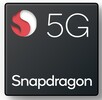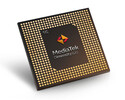Qualcomm Snapdragon 695 5G vs Unisoc T9100 (T820) vs MediaTek Dimensity 6020
Qualcomm Snapdragon 695 5G
► remove from comparison
The Qualcomm Snapdragon 695 5G (SD695) is a fast mid-range ARM-based SoC largely found on Android tablets and smartphones. It features 8 Kryo 660 called cores (64-Bit capable) that are divided in two clusters. A fast cluster of two cores with up to 2.2 GHz based on the ARM Cortex-A78 design. And a power saving efficiency cluster with up to 1.7 GHz based on much smaller ARM Cortex-A55 cores. Both clusters can also used together. The successor of the SD695 is the Snapdragon 6s Gen 3 with slightly higher clocked cores.
In addition to the 8 CPU cores, the SoC integrates a lower mid range Adreno 619 GPU, a X51 5G radio (up to 2.5 Gbits download, no mmWave), a 802.11ac (Wi-Fi 5, 8x8 sounding, Dual Band, 2x2), a Bluetooth 5.2 radio, satellite positioning (GPS, QZSS, GLONASS, SBAS, Beidou and Galileo) and a video engine (support for H.265, H.264, VP8 and VP9).
Compared to the previous SD690, the SD695 is now manufactured in 6nm (instead of 8nm) and offers a higher clocked performance cluster. However, the SD695 only supports Wi-Fi 5 instead of Wi-Fi 6 of the SD690.
Unisoc T9100 (T820)
► remove from comparison
The Unisoc T9100 (formely Unisoc T820) is a mid range SoC for Android based smartphones and tablets. It integrates an octa-core CPU with three clusters. One fast ARM Cortex-A76 clocked at up to 2.7 GHz, three more A76 performance cores clocked at up to 2.3 GHz and a power efficiency cluster of four ARM-Cortex-A55 cores with up to 2.1 GHz. The integrated memory controller supports LPDDR4/4X with up to 2133 MHz (2x 16 Bit). The integrated ISP supports two main cameras and two subsidiary cameras (up to 108 MPix). The integrated graphics card is an ARM Mali-G57 MC4 (4 cores) at up to 850 MHz. Unisoc also specifies that the T9100 offers hardware AI acceleration with up to 8.0 TOPS peak performance of the NPU.
The chip is manufactured on the modern 6nm EUV process.
MediaTek Dimensity 6020
► remove from comparison
The Mediatek Dimensity 6020 is a lower mid-range SoC with an integrated 5G modem. It includes two fast ARM Cortex-A76 cores at up to 2.2 GHz and six power efficient Cortex-A55 cores at up to 2 GHz (Octa-Core with Heterogeneous Multi-Processing). The specifications are similar to the old Dimensity 700 SoC.
Furthermore, the chip integrates a 2 core ARM Mali-G57 MC2 GPU, a Wi-fi 5 modem, a LPDDR4x-2133 memory controller, a AI processing unit (APU 3.0) and video de- and encoding.
The Dimensity 6020 is manufactured in the older 7nm process like the Dimensity 700.
| Model | Qualcomm Snapdragon 695 5G | Unisoc T9100 (T820) | MediaTek Dimensity 6020 | ||||||||||||
| Codename | Kryo 660 Gold (2x Cortex-A78) / Silver (6x Cortex-A55) | Cortex-A76 / A55 | Cortex-A76 / A55 | ||||||||||||
| Series | Qualcomm Snapdragon | Mediatek Dimensity 6000 | |||||||||||||
| Clock | 1700 - 2200 MHz | 2100 - 2700 MHz | 2000 - 2200 MHz | ||||||||||||
| Cores / Threads | 8 / 8 2 x 2.2 GHz ARM Cortex-A78 6 x 1.7 GHz ARM Cortex-A55 | 8 / 8 | 8 / 8 2 x 2.2 GHz ARM Cortex-A76 6 x 2.0 GHz ARM Cortex-A55 | ||||||||||||
| Technology | 6 nm | 6 nm | 7 nm | ||||||||||||
| Features | Adreno 619 GPU, X51 5G Modem, Hexagon 692 DSP, Spectra 355L ISP, FastConnect 6200 (Wi-Fi 5) | ISP (2 main + 2 subsidiary, 108M 9-in-1, 64M ZSL) | 2x ARM Cortex-A76 (2.2 GHz), 6x ARM Cortex-A55 (2 GHz), ARM Mali-G75 MC2, APU 3.0, 5G Modem (2CC), MiraVision (4K HDR Video, 80MP Photo), Wi-Fi 5, Bluetooth 5.1, UFS 2.2, 16GB LPDDR4x Support | ||||||||||||
| iGPU | Qualcomm Adreno 619 | ARM Mali-G57 MP4 ( - 850 MHz) | ARM Mali-G57 MP2 | ||||||||||||
| Architecture | ARM | ARM | ARM | ||||||||||||
| Announced | |||||||||||||||
| Manufacturer | www.qualcomm.com | www.mediatek.com | |||||||||||||
| Series: Dimensity 6000 Cortex-A76 / A55 |
|
Benchmarks
Average Benchmarks Qualcomm Snapdragon 695 5G → 100% n=6
Average Benchmarks Unisoc T9100 (T820) → 112% n=6
Average Benchmarks MediaTek Dimensity 6020 → 84% n=6
* Smaller numbers mean a higher performance
1 This benchmark is not used for the average calculation












